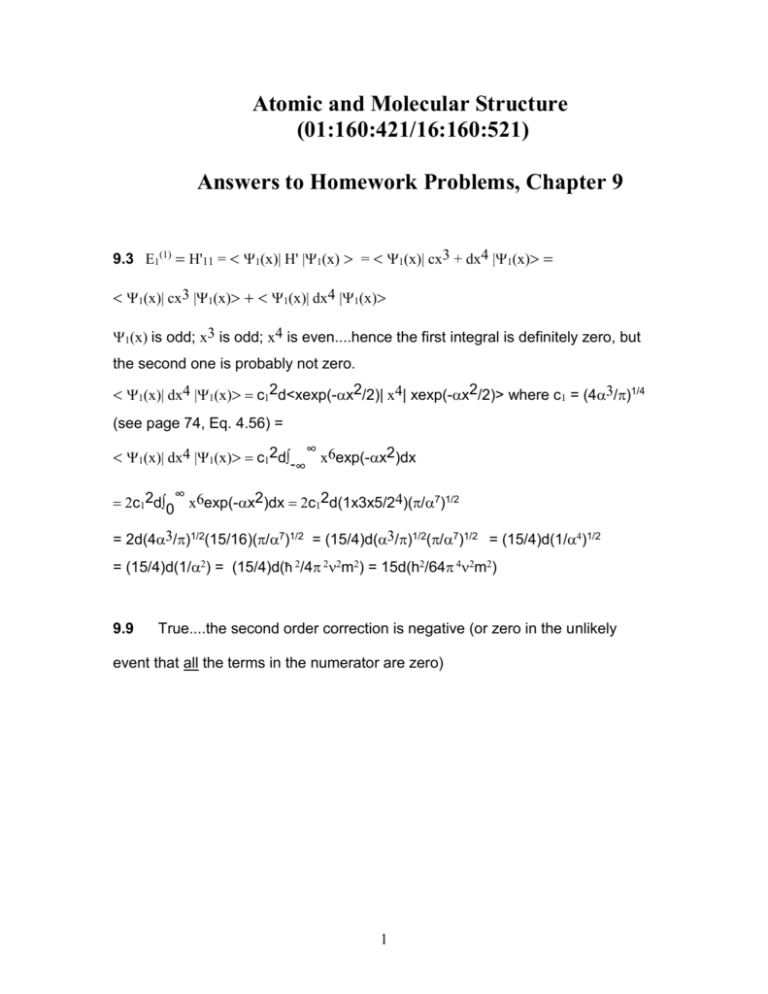Week11,F12,Answers
advertisement

Atomic and Molecular Structure
(01:160:421/16:160:521)
Answers to Homework Problems, Chapter 9
9.3 E1(1)H'11 = 1(x)| H' |1(x) = 1(x)| cx3 + dx4 |1(x)
1(x)| cx3 |1(x) 1(x)| dx4 |1(x)
1(x) is odd; x3 is odd; x4 is even....hence the first integral is definitely zero, but
the second one is probably not zero.
1(x)| dx4 |1(x)c12d<xexp(-x2/2)| x4| xexp(-x2/2)> where c1 = (43/)1/4
(see page 74, Eq. 4.56) =
∞ 6
x exp(-x2)dx
∞
1(x)| dx4 |1(x)c12d∫-
∞
c12d∫0 x6exp(-x2)dx c12d(1x3x5/24)(/7)1/2
= 2d(43/)1/2(15/16)(/7)1/2 = (15/4)d(3/)1/2(/7)1/2 = (15/4)d(1/)1/2
= (15/4)d(1/) = (15/4)d(ћ/4m) = 15d(h/64m)
9.9
True....the second order correction is negative (or zero in the unlikely
event that all the terms in the numerator are zero)
1
9.11
Ground state electronic configuration for H- is 1s2, just like He. The difference
between H- and He is that Z = 1 in the former, but Z = 2 in the latter.
= trial trialtrial()-1/2()3/2exp(-r1) ()-1/2()3/2exp(-r2)
Determine the value of which is optimal for the ground state of H
> will lead to
W() = 2 Z5/8
and
The difference between H- and He is that Z = 1 in the former but Z = 2 in the
latter.
Hence, for H-, Zeff = Zopt = = 1 - 5/16 = 11/16 and
Eopt = W()=9/16 = (11/16)2 5/8)(11/16) = 0.4727 -1.375 + 0.4297
= -0.4726 au = -12.86 eV > -13.605 eV, i.e. H- should be unstable with respect to
"dissociation" to a ground state H atom plus a free-flying electron.
H- H + e-
E = -13.605 eV - (-12.86 eV) = -0.745 eV
Using more functions, one can apparently drive the energy of H- down to -14.35
eV < -13.605 eV, so H- is in fact stable.
2
9.12 HHe-atom = [(-ћ2/2me)▼12 - 2e2/r1] + [(-ћ2/2me)▼22 - 2e2/r2] + e2/r12 =
go to au
[(-1/2)▼12 - 2/r1] + [(-1/2)▼22 - 2/r2] + 1/r12 =
reintroduce Z = 2 for clarity
[(-1/2)▼12 - Z/r1] + [(-1/2)▼22 - Z/r2] + 1/r12 =
[(-1/2)▼12 - 5/16r1] + [(-1/2)▼22 - 5/16r2] - (Z - 5/16/r1 - (Z - 5/16/r2 +1/r12
clever addition/subtraction of 5/16r1 and 5/16r2; rearrange
[(-1/2)▼12 - (Z - 5/16/r1] + [(-1/2)▼22 - (Z - 5/16/r2] - 5/16r1 - 5/16r2 +1/r12
= H0 + H'
where
H0 = [(-1/2)▼12 - (Z - 5/16/r1] + [(-1/2)▼22 - (Z - 5/16/r2]
H' = - 5/16r1 - 5/16r2 +1/r12
The unperturbed wavefunctions are the eigenfunctions of H0
i.e, the hydrogen-like wavefunctions nlm with Zeff = (Z - 5/16.
(r1)(r2) = n1,l1,m1(r1) n2,l2,m2(r2)
Zeff = (Z - 5/16 = 27/16
En1,n2 = En1 + En2 = -(Z - 5/162/(2n12) - (Z - 5/162/(2n22)
E(0) = En1=1 + En2=1 = -(2 - 5/162/(2x12) - (2 - 5/162/(2x12) = -(27/16)2
= -2.848 au = -77.49 eV
and
En(1) = n| H' |nH'nn =
100(r1)100(r2)| - 5/16r1 - 5/16r2 +1/r12 |100(r1)100(r2)
3
100(r1)| - 5/16r1 |100(r1)100(r2)| - 5/16r2|100(r2)
100(r1)100(r2)| 1/r12 |100(r1)100(r2)
(-5/16)(Z-5/16) + (-5/16)(Z-5/16) + (5/8)(Z-5/16) = 0 (!)
By cleverly choosing the zero-eth order Hamiltonian and associated
eigenfunctions, the first order energy correction became zero. That means, the
zero-eth order energy was, in fact, exact through first order in perturbation
theory.
The zero-eth order eigenfunctions were the variationally optimized eigenfunctions
for the He ground state, the results of having already done a variational
calculation. The variational calculation involves a minimization, i.e. it reaches a
stationary point in "function space". So this example shows, that if one starts a
perturbation theory calculation with variationally optimized wavefunctions, then
the first order correction may be zero (depending on what the perturbation is).
Logically, using variationally optimized wavefunctions will automatically be a
good start point for a perturbation theory calculation.
9.17 (a) The 2x2 matrix (H'ij – ESij) has the elements
4b – E
2b
2b
6b – E
The determinant should be equal to zero.
The determinant is (4b – E)(6b – E) – (2b)(2b) =
24b2 - 4bE - 6bE + E2 - 4b2 = E2 - 10bE + 20b2 = 0
The roots are E = {10b ± [102b2 – 4x1x20b2]1/2}/2 =
{10b ± [20b2]1/2}/2 = {(10b ± 2b[5]1/2}/2 = {5b ± 51/2b}
E1 = {5b + 51/2b}
E2 = {5b - 51/2b}
4
E1 + E2 = {5b + 51/2b} + {5b - 51/2b} = 10b (the trace (sum of diagonal
elements) of the Hamiltonian matrix is invariant)
(b) These values should next be plugged back into the secular equations to find
the coefficients.
The secular equations look like:
(4b – E) c1 + 2b c2 = 0
2b c1 + (6b – E) c2 = 0
Take E1 = {5b + 51/2b} and enter into either equation; solve for the ratio c2/c1;
then normalize
(4b – {5b + 51/2b}) c1 + 2b c2 = 0
(-b - 51/2b ) c1 + 2b c2 = 0 => (-1 - 51/2)c1/2 + c2 = 0
=>
-1.618c1 + c2 = 0 => c2/c1 = 1.618
So 1 = c1f1 + c2f2 = c1 (f1 + 1.618f2)
Normalization: c12 (<f1| f1> + (1.618)2< f2| f2> ) = 1
c12 (1 + 2.618) = 1 => c12 (3.618) = 1 => c1 = (1/3.618)1/2 = 0.525
1 = 0.525 (f1 + 1.618 f2)
E1 = {5b + 51/2b}
Take E2 = {5b - 51/2b} and enter into either equation; solve for the ratio c2/c1;
then normalize
(4b – {5b - 51/2b}) c1 + 2b c2 = 0
5
(-b + 51/2b ) c1 + 2b c2 = 0
=> (-1 + 51/2)c1/2 + c2 = 0 =>
0.618c1 + c2 = 0 => c2/c1 = -0.618
So 1 = c1f1 + c2f2 = c1 (f1 - 0.618f2)
Normalization: c12 (<f1| f1> + (0.618)2< f2| f2> ) = 1 => c12 (1 + 0.382) = 1
c12 (1.382) = 1 => c1 = (1/1.382)1/2 = 0.851
2 = 0.851(f1 - 0.618 f2)
E2 = (5b - 51/2b)
9.24 HHe-atom = [(-ћ2/2me)▼12 - 2e2/r1] + [(-ћ2/2me)▼22 - 2e2/r2] + e2/r12
E0n1,n2 = En1 + En2 = -Z2/(2n12) - Z2/(2n22)
E02s2 = E2s + E2s = -Z2/(2x22) - Z2/(2x22) = -22/(2x22) - 22/(2x22) = -1 Hartree
He(2s2) He+(1s) + eE = E(He+(1s)) - E(He(2s2)) = -2 Hartree - (-1 Hartree) = - 1 Hartree = -27.21
eV
He(2s2) is a highly unstable electronic configuration; 27.21 eV of energy would
be released if the He(2s2) configuration decayed to He+ (1s) + e-.
The first order correction: 200(r1)200(r2)| 1/r12 |200(r1)200(r2) J2s2s > 0
since it is the coulombic repulsion between two charge distributions, |200(r1)|2
and |200(r2)|2
Adding J2s2s to E02s2 = -1 Hartree is not going to improve the situation. The zeroeth order energy E02s2 is too high already when obtained from "no e-e repulsion
included" expressions. He(2s2) is not a stable electronic configuration.
6








